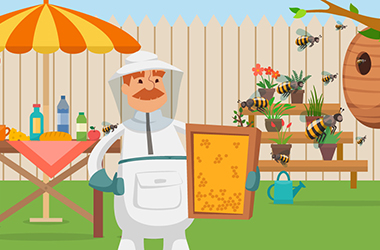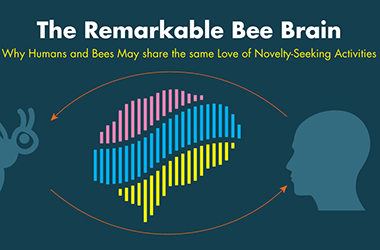
As backyard entertaining brings the indoors outdoors this summer, your backyard or pool deck may play host to quite a few cookouts and pool parties.
While we know that bees live in highly organized, efficient societies with each bee performing distinct duties in the colony in the service of the queen, researchers have come to the conclusion that some bees, like novelty-seeking humans display exploratory tendencies, indicating that some bees respond in the same way some humans do to thrill-seeking activities.
In a 2012 study published in the journal Science, University of Illinois professor and Institute for Genomic Biology director, Gene Robinson, along with a team of graduate students, discovered that humans and bees share some of the same gene activity patterns in molecular pathways related to thrill-seeking and an innate sense of adventure, formerly thought only to exist in humans and other vertebrates.
Bee adventurers go the extra mile for the survival of their colonies. In bee hives, only certain bees leave hives to hunt for new food sources and to find new accommodations once populations outgrow their current hives.
These scout bees, all females, take the initiative to fly out and hunt for new nests at a critical point when the hive divides and swarms of bees must find new homes in order for the hive to survive. Only about 5% of the swarm feels a higher calling and researchers also found that these nest scouts were, incidentally 3.4 times more likely to become food scouts, as well.
The fact that some scout bees will fly out repeatedly to find different sources for food and will also engage in missions, in search of new lodging points to the gold standard in personality behavior, according to Robinson. That standard showing the same tendencies in different contexts, points to bees exhibiting personality traits. That one bee might be predisposed to certain exceptional behavior, while others are not, suggests that bees might, in fact, possess personalities.
In the Illinois study, researchers set out to determine the molecular basis for these differences in honey bee behavior, using whole-genome microarray analysis to look for differences in the activity of thousands of genes in the brains of scouts and non-scouts.
While Robinson said that given all bees are foragers, non-scouts and scouts alike, they expected to see some differences in gene activity in scouting and non-scouting brains, but they were surprised at the degree of differences in brain activity between the two study groups.
Studying what makes humans and other animals engage in novelty-seeking behaviors, researchers are tossing around theories related to how thrill-seeking behavior is associated with the brains reward system, in response to certain experiences.
Because researchers in the University of Illinois study found many of the differentially expressed genes, in bee brains that related to GABA signaling in humans and other vertebrates, they narrowed their focus to catecholamine, glutamate and gamma-aminobutyric acid, as these neuro-transmitters are involved in regulating novelty-seeking and responding to rewards in vertebrates.
Testing their theories, Robinson and associates subjected groups of bees to these chemicals to determine whether or not changes in brain signaling caused novelty-seeking behavior in bees. The research group found that the chemicals glutamate and octopamine increased scouting behavior in previously non-scouting bees, that is to say, bees that had never scouted before. The team also concluded that when they blocked dopamine signaling, scouting behavior decreased.
Robinson said that this study showed that novelty-seeking behavior in humans, other vertebrates and now insects it appears, evolved along parallel genetic pathways. Natures genetic tool kit – the genes encoding certain molecular pathways, may be responsible for thrill-seeking behavior in different species, each adapting their own definition of novelty-seeking behavior to their own social structures. Evidently, the same molecular pathways have been used repeatedly in the evolution to generate novelty-seeking behavior.
While honeybees are essential to our survival as the globes most significant pollinators and do not usually attack people and pets, unless their colony is threatened, they still pose threats to human health as their venom can cause serious allergic reactions in sensitive people. Also, in recent years, feral bees that existed peacefully among ranchers and farmers, for decades are now showing aggression to people and animals, leading scientists to believe that all feral US bee populations have become Africanized.
Although bee activity decreases in cooler climates, during the fall and winter, in warmer areas, bee activity continues all year long. In Southern parts of the US, bees are as common in the fall as leaves changing. Considered nuisance pests around your home or business any time of year, bees and wasps should be handled by a professional pest control company. Truly Nolen eliminates bees and wasps on your property and offers beehive removal and other programs, such as scout traps to deter bees from settling in too close for comfort to you and your loved ones. Contact Truly Nolen to schedule a free pest inspectionand to determine an appropriate plan to keep your home pest-free, throughout the year.

As backyard entertaining brings the indoors outdoors this summer, your backyard or pool deck may play host to quite a few cookouts and pool parties.

Bee adventurers go the extra mile for the survival of their colonies. In bee hives, only certain bees leave hives to hunt for new food sources and to find new accommodations once populations outgrow their current hives.